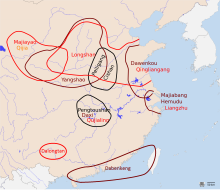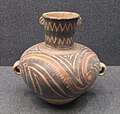The 5th millennium BC spanned the years 5000 BC to 4001 BC. It is impossible to precisely date events that happened around the time of this millennium and all dates mentioned here are estimates mostly based on geological and anthropological analysis.
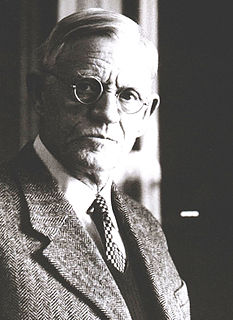
Klas Bernhard Johannes Karlgren was a Swedish sinologist and linguist who pioneered the study of Chinese historical phonology using modern comparative methods. In the early 20th century, Karlgren conducted large surveys of the varieties of Chinese and studied historical information on rhyming in ancient Chinese poetry, then used them to create the first ever complete reconstructions of what are now called Middle Chinese and Old Chinese.

The Yangshao culture was a Neolithic culture that existed extensively along the middle reaches of the Yellow River in China from around 5000 BC to 3000 BC. The culture is named after the Yangshao site, the first excavated site of this culture, which was discovered in 1921 in Yangshao town, Mianchi County, Henan Province by the Swedish geologist Johan Gunnar Andersson (1874–1960). The culture flourished mainly in the provinces of Henan, Shaanxi and Shanxi.

The Longshanculture, also sometimes referred to as the Black Pottery Culture, was a late Neolithic culture in the middle and lower Yellow River valley areas of northern China from about 3000 to 1900 BC. The first archaeological find of this culture took place at the Chengziya Archaeological Site in 1928, with the first excavations in 1930 and 1931. The culture is named after the nearby modern town of Longshan in Zhangqiu, Shandong. The culture was noted for its highly polished black pottery. The population expanded dramatically during the 3rd millennium BC, with many settlements having rammed earth walls. It decreased in most areas around 2000 BC until the central area evolved into the Bronze Age Erlitou culture. The Longshan culture has been linked to the early Sinitic . According to the area and cultural type, the Longshan culture can be divided into two types: Shandong Longshan and Henan Longshan. Among them, Shandong Longshan Cultural Site includes Chengziya Site; Henan Longshan Cultural Site includes Dengfeng Wangchenggang Site in Wangwan, Taosi Site and Mengzhuang Site in Hougang.

Johan Gunnar Andersson was a Swedish archaeologist, paleontologist and geologist, closely associated with the beginnings of Chinese archaeology in the 1920s.

The Hongshan culture was a Neolithic culture in the West Liao river basin in northeast China. Hongshan sites have been found in an area stretching from Inner Mongolia to Liaoning, and dated from about 4700 to 2900 BC.

The Dawenkou culture was a Chinese Neolithic culture primarily located in the eastern province of Shandong, but also appearing in Anhui, Henan and Jiangsu. The culture existed from 4100 to 2600 BC, and co-existed with the Yangshao culture. Turquoise, jade and ivory artefacts are commonly found at Dawenkou sites. The earliest examples of alligator drums appear at Dawenkou sites. Neolithic signs, perhaps related to subsequent scripts, such as those of the Shang Dynasty, have been found on Dawenkou pottery.

The Majiayao culture was a group of neolithic communities who lived primarily in the upper Yellow River region in eastern Gansu, eastern Qinghai and northern Sichuan, China. The culture existed from 3300 to 2000 BC. The Majiayao culture represents the first time that the upper Yellow River region was widely occupied by agricultural communities and it is famous for its painted pottery, which is regarded as a peak of pottery manufacturing at that time.
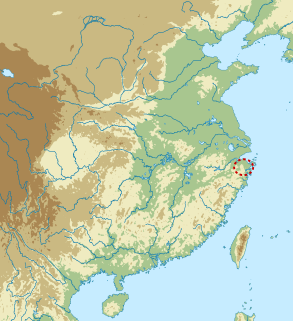
The Hemudu culture was a Neolithic culture that flourished just south of the Hangzhou Bay in Jiangnan in modern Yuyao, Zhejiang, China. The culture may be divided into early and late phases, before and after 4000 BC respectively. The site at Hemudu, 22 km northwest of Ningbo, was discovered in 1973. Hemudu sites were also discovered at Tianluoshan in Yuyao city, and on the islands of Zhoushan. Hemudu are said to have differed physically from inhabitants of the Yellow River sites to the north. Some authors propose that the Hemudu Culture was a source of the pre-Austronesian cultures.
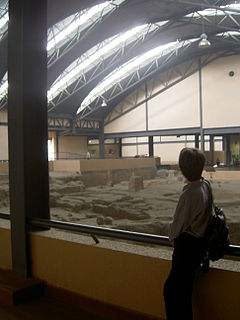
Banpo is an archaeological site discovered in 1953 and located in the Yellow River Valley just east of Xi'an, China. It contains the remains of several well organized Neolithic settlements, like Jiangzhai, carbon dated to 6700–5600 years ago. The area of 5 to 6 hectares is surrounded by a ditch, probably a defensive moat, 5 to 6 meters wide. The houses were circular, built of mud and wood with overhanging thatched roofs. They sat on low foundations. There appear to be communal burial areas.
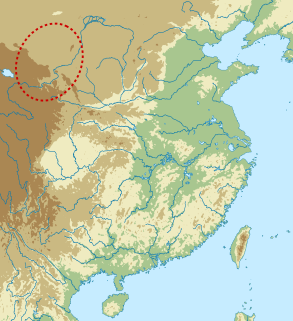
The Qijia culture was an early Bronze Age culture distributed around the upper Yellow River region of Gansu and eastern Qinghai, China. It is regarded as one of the earliest bronze cultures in China.

The Karuo culture was a Neolithic culture in Tibet. The culture cultivated foxtail millet.

The Dadiwan culture was a Neolithic culture located primarily in the eastern portion of Gansu and Shaanxi provinces in modern China. The culture takes its name from the deepest cultural layer found during the original excavation of the type site at Dadiwan. The remains of millet, pigs and dogs have been found in sites associated with the culture, which is itself defined by a thin-walled, cord-marked ceramic tradition sometimes referred to as Laoguantai. The Dadiwan culture shares a variety of common features, in pottery, architecture, and economy, with the Cishan and Peiligang cultures to the east.

Metallurgy in China has a long history, with the earliest metal objects in China dating back to around 3,000 BCE. The majority of early metal items found in China come from the North-Western Region. China was the earliest civilization to use the blast furnace and produce cast iron.
East Yi West Xia is an obsolete theory about the origin of prehistory culture in current China which says that the culture of Shang dynasty was established by two ethnic groups; namely, that the Western part of the Shang dynasty was developed by Xia ethnic group, and the eastern part of Shang dynasty was developed by Yi ethnic group.

The Museum of Far Eastern Antiquities, located in Stockholm, Sweden, is a museum launched by Sweden's Parliament in 1926, with the Swedish archaeologist Johan Gunnar Andersson (1874–1960) as founding director. The museum is located on Skeppsholmen in the building Tyghuset and since 1999 the museum is a part of the public Swedish National Museums of World Culture.

Jiangzhai is a Banpo phase Yangshao culture archaeological site in the east of Xi'an, where the earliest copper artifacts in China were found.
Professor Robert Ture Olov Janse was a Swedish archaeologist. He is notable for his excavation work at Đông Sơn between 1935 and 1939. Though he originally argued a viewpoint for the European origins of Bronze Age culture in Vietnam, he reversed himself in support of Chinese origins after he started excavations at Đông Sơn. Janse is characterized as having introduced order into the research of the history of archaeology in Mainland Southeast Asia.

Chinese archaeology has been practiced since the Song dynasty (960-1279) with early practices of antiquarianism. Although native Chinese antiquarianism developed some rigorous methods of unearthing, studying, and cataloging ancient artifacts, the field of archaeology in China never developed into a branch of study outside of Chinese historiography. Native Chinese antiquarian studies waned after the Song period but were revived during the Qing dynasty (1644-1912). Rigorous standards of modern Chinese archaeology were first developed at the turn of the 20th century by Chinese archaeologists educated in the West and in the early Republic of China (1912–1949).
Yangguanzhai is an archaeological site discovered in 2004 at Gaoling County, Shaanxi Province. The site is associated with the Miaodigou phase of the Yangshao culture. As of 2009, survey data suggests the cultural remains at Yangguanzhai cover an area of over 800,000 square meters, making it one of the largest Neolithic sites in China.
